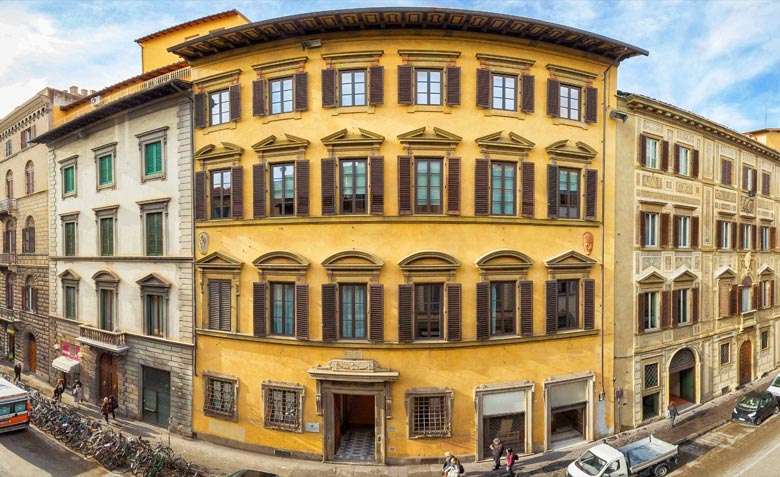
Palazzo Niccolini, the AEF Headquarters, is a historic building located on via Cavour n. 37, one of the most important streets of the city of Florence. Originally, it was called via Larga degli Spadai due to the presence of numerous workshops of armorers who forged swords, but soon the name is simplified in Via Larga in everyday use.
During that time, what made the road magnificent was its breadth compared to others, as evidenced by the 18th century engraving by Giuseppe Zocchi. The current name is dedicated to Camillo Benso, Count of Cavour, a central figure in Italian history, who fundamentally contributed to the unification of the Italian State. He died a few months after the proclamation of the Kingdom of Italy, which took place on March 17, 1861, and in the wake of patriotic emotions and enthusiasm, on June 27 of the same year, Marquis Ferdinando Bartolommei, standard-bearer of Florence, proposed to name the street after him, which up until then had been called Via Larga.
For many centuries, Via Larga had been the favorite place for shows and jousting, as we can see in Giovanni Stradano’s 1561 fresco in Palazzo Vecchio, where the crowd follows the Saracino joust. It became even more important in the 1400’s, when the Medici family decided to build the famous Palazzo Medici, one of the foremost monuments of the Renaissance. From that moment on, the street became a lively political and financial center where one could encounter rich merchants and powerful public figures. It is here that in 1494 King Charles VIII of France was welcomed.
The oldest owners of Palazzo Niccolini were members of the Salvatici family who built it upon three previous houses. The property changed several times over the centuries: In 1755, Ippolito Scaramucci bought the palace; in 1794, it passed to the Borghi, whose descendants in 1850 sold it to Alessandro Tognozzi-Moreni, who belonged to a family ennobled at the end of the 18th century. The descendants of the Tognozzi-Moreni family sold it to the Manetti & Roberts Company in 1940. The façade of the building is plastered and spread over four floors distributed on six axes. On the ground floor, the façade appears asymmetrical and the door in a decentralized position. The three windows, protected by grates, retain an elegant relief frame of eighteenth-century design.
In historic Florentine buildings, the first floor was called "piano nobile": this is where the owners received guests and held dances and banquets. In "our" Palazzo Niccolini, the four central windows of the main floor are crowned by a semi-circular tympanum, while the two external ones are triangular. The windows of the upper floors have a different decoration. On the façade there are two coats of arms: a stone shield with the emblem of the Salvatici family, and a terracotta shield attributed to the Tognozzi-Moreni family.
The building is named after Giovan Battista Niccolini, famous Thespian born in 1782 in the province of Pisa and died here, as per the inscription on the façade. A young man of republican and anti-clerical sentiments, he composed political tragedies that had only one purpose: the condemnation of tyranny, especially theocratic tyranny. He was born into a poor family but thanks to his talent, was protected by Princess Elisa, queen of Etruria, and obtained the position of secretary of the Academy of Fine Arts in Florence. His first dramatic work was Polissena, published in 1810, which was followed by Edipo, I Sette a Tebe, Agamennone and Medea.
Teatro del Cocomero, currently Teatro Niccolini, was also dedicated to Giovan Battista Niccolini; located on Via Ricasoli and overlooking the Duomo and Via Niccolini in Florence. Niccolini’s tomb is located in the Pantheon of the Florentines, or what is the Basilica of Santa Croce: it is a monumental tomb, with a massive marble sculpture by Pio Fedi, which depicts the Statue of Liberty of Poetry. It was just this monument that inspired French sculptor Bartholdi, for his very famous Statue of Liberty in New York. Discovering the history of our Palazzo Niccolini, home of AEF, would not have been possible without the invaluable help and in-depth study done by Martina Massimilla, a young and passionate archivist. We all thank you for enlightening us with this piece of history and making us even more aware of how lucky we are to be studying, working, and above all, living every day in this wonderful Palazzo!



